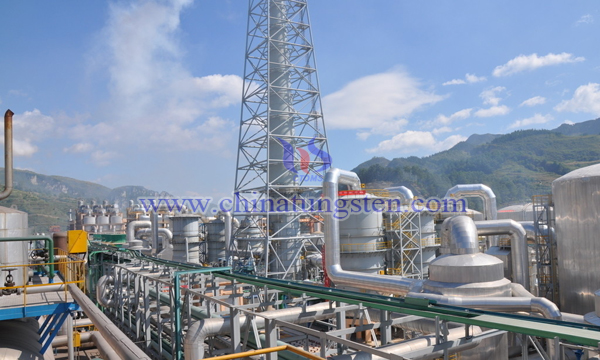Scheelite Treatment by Sulfuric Acid-Phosphoric Acid Decomposition
- Details
- Category: Tungsten Information
- Published on Friday, 31 May 2019 10:30
At present, wolframite is the main resource consumed in tungsten smelting in China, and the basic reserves of wolframite resources will be exhausted in a few years. In addition, most of the newly discovered tungsten resources are complex scheelite resources, which has shown the absolute predominance of scheelite. Therefore, the development of scheelite resources to replace wolframite is a strategic choice for the sustainable development of tungsten industry in China.

In order to solve the problem of hydrochloric acid corrosion and volatilization, some scholars have considered using sulfuric acid instead of hydrochloric acid to achieve complex leaching of tungsten. However, in the presence of a large amount of sulfuric acid, the supersaturation of the solution to calcium sulfate is extremely large, which often leads to rapid nucleation of gypsum to form a large number of fine crystals, resulting in a package, which makes the decomposition effect unsatisfactory. To this end, some scholars have developed a process for the treatment of scheelite by a sulfuric acid-phosphoric acid decomposition process, the main contents of which include:
Prepare a phosphoric acid solution with a P2O5 quality concentration of 5% to 35%, add sulfuric acid and control SO42-, the concentration is from 0.10g/ml to 0.40g/ml, and after heating to 70-100 °C, add scheelite to the solution. The reaction is carried out at a liquid-solid ratio of 3:1 to 8:1 ml/g, and the reaction time is 1 to 6 hours. After the completion of the reaction, the filtrate obtained by filtration is subjected to basic ion exchange, alkaline solvent extraction or ammonium salt precipitation to extract tungsten.
The wolframite contains 10%-75% WO3 and its fineness is not more than 100 meshes. The mother liquor after tungsten extraction was added with sulfuric acid and phosphoric acid and then returned to leaching.
Due to the complexation of calcium ions with phosphoric acid, the solubility of calcium sulfate increases gradually with the increase of phosphoric acid concentration in solution, reaching the maximum at about 20% of P2O5 (5-7 times as high as that in the absence of phosphoric acid at 80 ℃). Even when P2O5 is increased to about 40%, the solubility is still 3 to 5 times as high as that in the absence of phosphoric acid. Therefore, appropriate high concentration of phosphoric acid is beneficial to reduce the supersaturation of calcium sulfate in the decomposition of tungsten ore, and it is possible to reduce the spontaneous nucleation rate of calcium sulfate, thus promoting the formation of coarse crystals; moreover, high concentration of phosphoric acid is also beneficial to the formation of soluble phosphotungstic heteropoly acid and avoiding the encapsulation of tungstic acid precipitation; in addition, phosphoric acid has a low corrosivity. There is no evaporation problem like hydrochloric acid.
There is no strict requirement for the impurity phosphorus content of scheelite treated. In the process of scheelite beneficiation, no special phosphorus removal process is needed, which saves the cost of phosphorus removal reagent and the loss of tungsten. After the reaction, tungsten enters the filtrate and only needs to be extracted by simple post-treatment methods such as ion exchange, solvent extraction or ammonium salt precipitation, which simplifies the operation, reduces the cost and decomposes it. The rate can reach over 98%.
- Tungsten Oxide Manufacturer & Supplier, Chinatungsten Online: www.tungsten-oxide.com
- Tungsten News & Prices of China Tungsten Industry Association: www.ctia.com.cn
- Molybdenum News & Price: news.molybdenum.com.cn
- Tel.: 86 592 5129696; Fax: 86 592 5129797; Email: sales@chinatungsten.com



 sales@chinatungsten.com
sales@chinatungsten.com